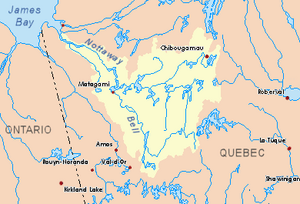Capousacataca River facts for kids
Quick facts for kids Capousacataca |
|
|---|---|

Watershed of Nottaway River
|
|
| Country | Canada |
| Province | Quebec |
| Region | Abitibi-Témiscamingue |
| Physical characteristics | |
| Main source | Leigne Lake Senneterre, La Vallée-de-l'Or Regional County Municipality (RCM), Abitibi-Témiscamingue, Quebec 389 m (1,276 ft) 48°40′06″N 76°09′33″W / 48.66833°N 76.15917°W |
| River mouth | Mégiscane River Senneterre, La Vallée-de-l'Or Regional County Municipality, Abitibi-Témiscamingue, Quebec 385 m (1,263 ft) 48°30′37″N 76°25′05″W / 48.51028°N 76.41806°W |
| Length | 17.4 km (10.8 mi) |
| Basin features | |
| Tributaries |
|
The Capousacataca River is a small river in Quebec, Canada. It flows into the Mégiscane River. You can find it in the north-eastern part of Senneterre, a town in the Abitibi-Témiscamingue region.
This river flows through thick forests. It is located near the La Vérendrye Wildlife Reserve and the Gouin Reservoir. The main activities in this area are forestry and outdoor tourism. The river usually freezes over from early December until the end of April. A forest road, R0808, follows the river valley.
Where Does the River Start and End?
The Capousacataca River begins near the northern border of the Abitibi-Témiscamingue region. It starts at the mouth of a lake called Valets.
The river then flows for about 17.4 km (10.8 mi). It winds through the forest, passing through a few lakes that are actually wider parts of the river itself.
The Capousacataca River empties into the Mégiscane River. The Mégiscane River usually flows west. It is a branch of Parent Lake. Parent Lake then flows into the Bell River. The Bell River leads to Matagami Lake, which eventually flows into the Nottaway River. The Nottaway River finally reaches the southeastern part of James Bay.
What Does the Name Mean?
The name "Capousacataca River" comes from the Algonquin people. It means "where there is a lot of dry wood." This name has been used on maps since at least 1940.
The official name "Capousacataca River" was formally recognized on December 5, 1968. This was done by the Commission de toponymie du Québec, which is the official body for naming places in Quebec.

